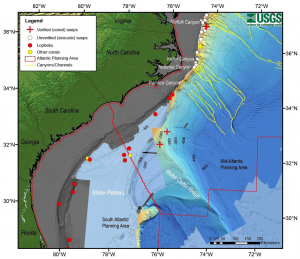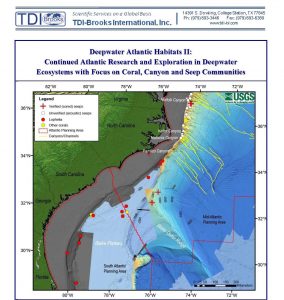TDI-Brooks International, Inc. has been awarded the Bureau of Ocean Energy Management (BOEM), the National Oceanic and Atmospheric Administration (NOAA) Office of Ocean Exploration and Research (OER), and the U.S. Geological Survey (USGS) funded study entitled “Deepwater Atlantic Habitats II: Continued Atlantic Research and Exploration in Deepwater Ecosystems with Focus on Coral, Canyon and Seep Communities.” This interagency five (5) year, multi-million dollar study shall focus on the exploration and investigation of deepwater biological communities located in U.S. federal waters of the northwest Atlantic Ocean, potentially including offshore Virginia, North Carolina, South Carolina, and Georgia (Figure below). The program focus is on hard substrate habitats, with some work related to soft bottoms and within the water column also included. Results of the completed program will provide energy resource information needs for future offshore leasing of the Outer Continental Shelf in the mid and south Atlantic regions and information on the continental shelf ecosystems.

Broad view of study area between Norfolk Canyon and Florida/Georgia border including bathymetry, gas seep and deep-water coral locations.
Approximately eighteen (18) days of ship time for the initial cruise (2017) and up to twenty four (24) days for each of the subsequent research cruises (2018 and 2019) aboard NOAA-research vessels (e.g. NOAAS Ronald H. Brown), will be provided to the program by NOAA OER. A remotely operated vehicle (ROV), or autonomous underwater vehicle (AUV) will also be available from NOAA OER for all three cruises.
The overarching goal for this project is to augment the ability to predict the location of seafloor communities within the study area that are potentially sensitive to natural and anthropogenic disturbances. This area encompasses a variety of different habitat types, including canyons, hard-bottoms, cold-water coral mounds, methane seeps, and soft sediments. Below are a series of objectives to develop this predictive capacity, starting with an improved understanding of the distribution, structure, and function of the communities associated with each habitat type.
- Explore and characterize the biological communities of the study area. This will include community descriptions from microbial to megafaunal scales, and their association with the three different focal habitat types. In addition, soundscapes will be generated for each targeted community to explore the relationship between selected habitat types and acoustic bioindicators. Species identifications will be determined by a combination of molecular and morphological methods in collaboration with our network of taxonomic colleagues. These investigations will complement those of the USGS collaborators to provide a comprehensive picture of community structure, function and habitat association. Ecosystem data will be interpreted in a trans-Atlantic context by integrating the data generated in this study with our existing data, and through our collaborations with ADEON, the NOAA Deep Sea Coral Research and Technology Program and other NOAA projects, the large EU consortia ATLAS and SponGES, and our other Canadian and European colleagues.
- Examine the sensitivity of habitat-structuring fauna and associated communities to natural and anthropogenic disturbance. We will address this objective using a combination of laboratory and field experiments, information on age structure and population dynamics of key species, the rarity of species and assemblages, and the genetic connectivity of dominant species. The application of acoustic bioindicators and acoustic similarity/dissimilarity indices will provide novel metrics for quantitative comparisons of the impact of different levels of disturbance between locations. All of these will be examined in collaboration with USGS colleagues and interpreted in a trans-Atlantic context with collaborators outside the US.
- Describe the oceanographic, geological, and geochemical conditions associated with each habitat type. These characterizations will include time-series measurements of water column temperature, salinity, dissolved oxygen, turbidity, and fluorometry, along with sediment biogeochemistry, water-column and pore-fluid methane concentrations (through direct measurements, in situ samplers, and bubble-plume data from multibeam surveys), pH and carbonate chemistry, nutrients and organics, physical oceanography (with ADEON and European collaborators), and geomorphology (with USGS). In particular, detailed biogeochemical studies of coral, canyon, and seep habitats in the study area are lacking.
- Model the distribution of habitats and fauna with respect to environmental conditions. In the synthesis phase, we will interpret the geological (geomorphology and habitat type) and biological data (species and community distributions) in the context of the environmental data described above. This information will be incorporated into a quantitative, ensemble modeling framework at the ecosystem scale, to achieve a robust predictive capacity for the distribution of target communities (coral-sponge, methane seep) within the study area. We will expand this interpretation to an ocean-scale context with the NOAA DSCRTP and our European collaborators.
The Deepwater Atlantic Habitats II program will be the third major federal research program that TDI-Brooks International has led over the last decade. Previously, the LopheliaII and Chemosynthesis III programs were major, multi-year federal programs won by a coalition of partners, many of whom are also principals in this effort. The TDI-Brooks team consists of scientists from Temple University, University of Georgia, Nova University, Florida State University, Harvey Mudd College and University of New Hampshire as well as experts from numerous international universities.
TDI-Brooks International, Inc. offers a comprehensive suite of offshore geotechnical field services, including piston coring, jumbo piston coring, box coring, and the deployment of multiple CPT tools. Our vessels can also be used to accommodate some third party geotechnical equipment packages. Geotechnical analytical services are offered to complement our field services.

